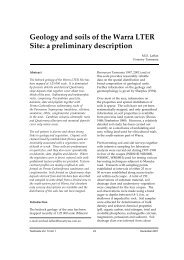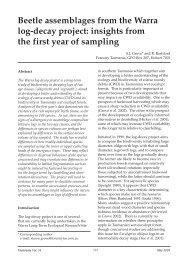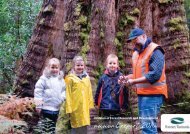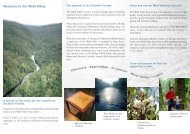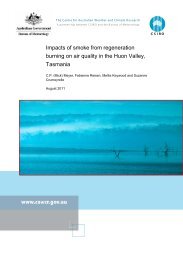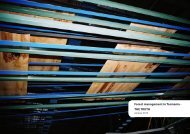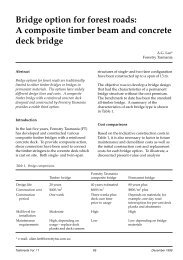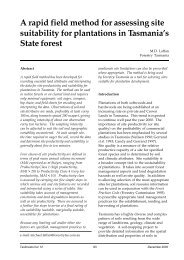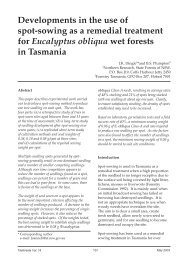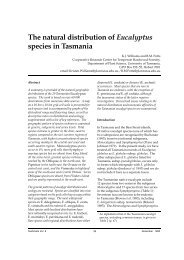sustainable forest management - Forestry Tasmania
sustainable forest management - Forestry Tasmania
sustainable forest management - Forestry Tasmania
You also want an ePaper? Increase the reach of your titles
YUMPU automatically turns print PDFs into web optimized ePapers that Google loves.
Research<br />
<strong>Forestry</strong> <strong>Tasmania</strong> has a significant investment in research<br />
and development. The research capacity is concentrated<br />
in the Division of Forest Research and Development<br />
(DFRD). The three goals of productivity, sustainability and<br />
profitability guide the division’s research planning. Much of<br />
DFRD’s research is performed in collaboration with others,<br />
as this is by far the most cost-effective way to bring into<br />
<strong>Forestry</strong> <strong>Tasmania</strong> the wide range of relevant expertise<br />
and knowledge in other institutions. Examples of these<br />
collaborations are participation in the CRC for <strong>Forestry</strong>, the<br />
Bush Fire CRC and a number of Australian Research Council<br />
linkage grants.<br />
Research thus informs <strong>forest</strong> <strong>management</strong> and operations<br />
directly as part of <strong>Forestry</strong> <strong>Tasmania</strong>’s daily business, but it<br />
is also important that this is specifically demonstrated and<br />
communicated to the wider community. The scientific and<br />
technical staff of DFRD are therefore involved in publicising<br />
research and its implementation. DFRD is a significant<br />
player in National Science Week activities in <strong>Tasmania</strong>.<br />
The job of a DFRD researcher requires maintaining an<br />
awareness of national and international developments<br />
in their <strong>forest</strong> science speciality, performing their own<br />
research, and ensuring that results are used to inform<br />
<strong>Forestry</strong> <strong>Tasmania</strong>’s <strong>forest</strong> <strong>management</strong> and operations,<br />
as well as being involved in publicising their work. The<br />
strength of the research carried out in DFRD is grounded in<br />
its close links with both practical <strong>forest</strong> <strong>management</strong> and<br />
policy setting in a commercial environment.<br />
Research highlights in 2007/08 included:<br />
Developing landscape metrics to quantify the contribution of<br />
late succession <strong>forest</strong>s to landscape structure in the Greater<br />
Warra Experimental Forest Landscape.<br />
Exploration of a range of landscape metrics and<br />
methodologies using the Greater Warra Experimental<br />
Forest Landscape study area to develop a set of applied<br />
ecologically meaningful landscape metrics to be used<br />
<strong>forest</strong>s to landscape structure in a spatially heterogeneous<br />
production <strong>forest</strong> landscape.<br />
Social acceptability of <strong>forest</strong> <strong>management</strong> options –<br />
landscape visualisation and evaluation (in conjunction with<br />
Melbourne University).<br />
Comparing the social acceptability of alternative landscape<br />
<strong>management</strong> options for an area in the southern <strong>forest</strong>s<br />
from Port Huon in the east to Mt Picton in the west.<br />
for research and <strong>forest</strong> <strong>management</strong> planning reporting<br />
purposes. Proximity metrics were found to be a useful<br />
means for quantifying the contribution of late succession<br />
Learn more about <strong>Forestry</strong> <strong>Tasmania</strong>’s research<br />
programs and read the Division of Forest<br />
Research’s Annual Report at:<br />
Table 16. Research Expenditure Summary<br />
www.<strong>forest</strong>rytas.com.au/science<br />
2002/03 2003/04 2004/05 2005/06 2006/07 2007/08<br />
$3,305,000 $3,494,000 $3,645,800 $3,839,200 $4,343,200 $4,387,000<br />
Figure 40. Research expenditure as a percentage of net operating costs<br />
Figure 40. Research expenditure as a percentage of net operating costs<br />
4.5%<br />
5,000,000<br />
% Net Operating Cost<br />
4.0%<br />
3.5%<br />
% Net Operating Cost<br />
3.5%<br />
3.0%<br />
2.5%<br />
2.0%<br />
2.0%<br />
1.5%<br />
1.0%<br />
0.5%<br />
0.0%<br />
0<br />
2000/2001 2001/2002 2002/2003 2003/2004 2004/2005 2005/2006 2006/2007 2007/2008<br />
2000/01<br />
% Net Operating Cost Value ($)<br />
% Net Operating Cost . Value ($)<br />
2001/02<br />
2002/03<br />
2003/04<br />
2004/05<br />
2005/06<br />
2006/07<br />
2007/08<br />
4,500,000<br />
4,500,000<br />
4,000,000<br />
4,000,000<br />
3,500,000<br />
3,500,000<br />
3,000,000<br />
2,500,000<br />
2,000,000<br />
1,500,000<br />
1,000,000<br />
500,000<br />
Amount Spent ($)<br />
3,000,000<br />
2,500,000<br />
2,000,000<br />
1,500,000<br />
1,000,000<br />
500,000<br />
0<br />
Amount Spent ($)




